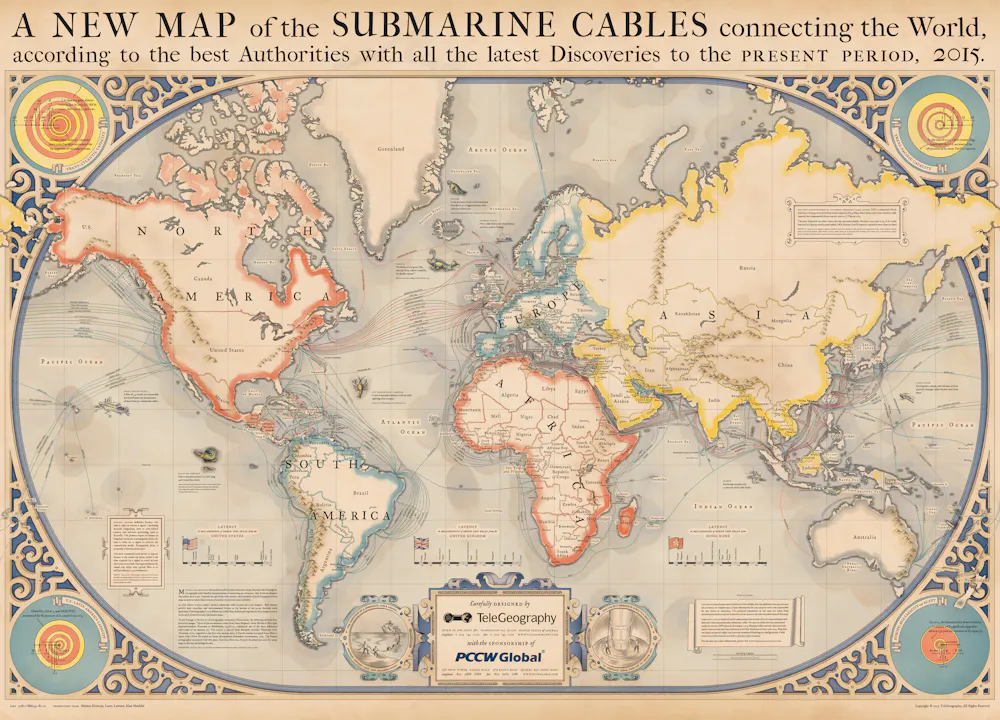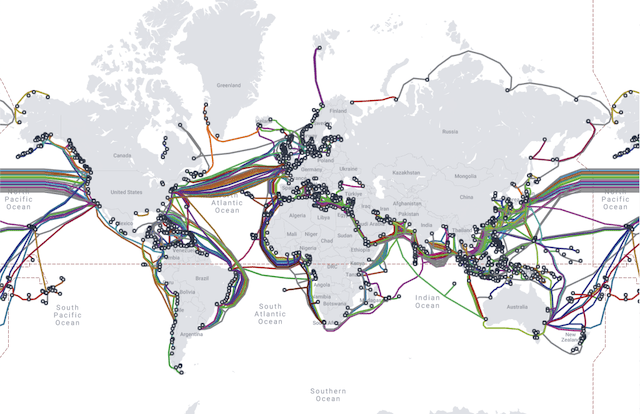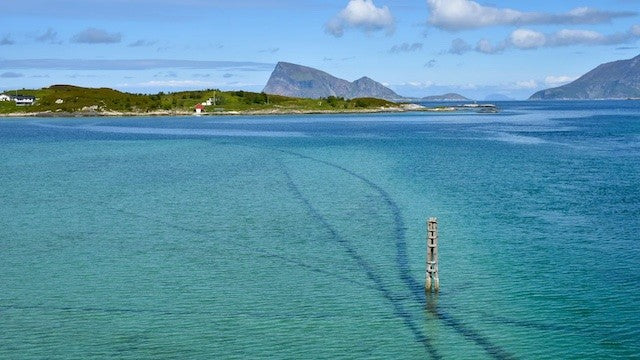
Undersea Cables: Connecting the World and Disturbing Marine Life
Table of Contents
Not many people know that a huge network of undersea cables forms the backbone of our global communication systems. While there is an obvious convenience in the speed of data transmission and connection for areas that would be otherwise disconnected, we must also consider the potential repercussions of our technological progress on the delicate ecosystems beneath the ocean’s surface.

There is always an opportunity cost when it comes to new technology, and many are concerned that we as a society may be overlooking some environmental consequences of these undersea cables.
Aires Tech was founded on the concerns of electronic technology’s effect on human health, but the concerns around electromagnetic fields (EMFs) producing technology extend to all biological organisms, as we are all interconnected through a shared environment on this beautiful planet.
This blog post explores the intricate relationship between undersea cables and marine life, exploring the potential impact of EMFs and the role of innovative solutions in preserving our oceans.
What Are Undersea Cables?
Undersea cables are often referred to as the arteries of the global communication system. These cables operate as conduits for energy and data beneath the ocean’s surface, utilizing advanced technology to transmit vast amounts of information across continents.

The cables are typically either fiber-optic (data transfer, aka internet) or copper wires (power cables for distribution of electricity; think of wind farms) encased in protective layers.
How Undersea Cables Work
They function by transmitting data in the form of light pulses (in the case of fiber-optic cables) or electrical signals (in the case of copper power cables).
The design ensures reliable and efficient data and power transmission, allowing for real-time communication and the transfer of massive amounts of information at extreme speeds. Beyond their initial role in connecting the world, undersea cables have become a vital component in ocean-based renewable energy projects, used to harness the natural power of the wind and waves and distribute power across the globe.
Exponential Growth in Undersea Cable Expansion
The rapid growth of undersea cables has mirrored the explosive expansion of our digital world since the 1990s.
The demand for increased bandwidth, faster data transmission, and enhanced global connectivity has brought a surge in the installation of undersea cables. As technology continues to advance and societies become more reliant on digital communication, the undersea cable industry has responded by deploying an increasingly extensive network of cables across oceans and seas.
The scale of this growth is clear when you look at the sheer number of recent installations connecting continents and remote regions alike.

This exponential rollout of new cables is a clear measure of the role undersea cables play in our modern communication and power infrastructure.
Such a massive amount of wiring raises certainly raises important questions about the environmental impact and sustainability of this network.
As we continue this unprecedented growth of a fairly new technology, it becomes increasingly necessary to consider the balance between technological progress and the preservation of marine ecosystems.
Why Don’t Satellites Replace Undersea Cables?
Unfortunately, satellite technology cannot completely replace undersea cables; not yet anyways.
While satellites do play a crucial role in global communication, they cannot fully replace undersea cables due to several inherent limitations in their technology. Undersea cables offer significantly higher data transfer capacities and lower latency compared to satellite communication. The physical properties of fiber-optic cables allow for the transmission of enormous amounts of data at very high speeds, making them more efficient for large-scale and high-bandwidth applications.
Additionally, undersea cables are not affected by atmospheric conditions that can impact satellite signals, ensuring more consistent and reliable connectivity. The cost of deploying and maintaining undersea cables has also decreased over the years, making them a more economically viable option for sustaining the ever-growing demand for data transmission.
While satellites serve an increasingly valuable purpose, particularly in remote and inaccessible areas, the critical role of undersea cables in forming the foundation of global communication infrastructure remains unparalleled. The combination of both technologies is what has allowed us to meet the diverse and immense needs of our electronically interconnected world.
EMFs Impact on Marine Life
Beyond the more obvious concerns around disturbances of the physical environment in marine ecosystems, there lies a critical concern regarding the potential impact of the electromagnetic radiation (EMR) that is produced by these cables.
As these cables crisscross the ocean floor, they are undeniably introducing EMFs into marine environments. EMFs, an inevitable byproduct of the energy required for data and power transmission, have been a subject of growing scientific inquiry and concern.
The concerns are centered around the potential effects of EMF on marine-dwelling organisms. Recent studies suggest that marine organisms, particularly those with intricate sensory systems, may be sensitive to these fields, potentially leading to behavioral changes and ecological disruptions.
What We Know about EMFs’ Effects on Marine Life
- Behavioral Changes: Studies suggest that electromagnetic fields (EMFs) from undersea cables may induce behavioral alterations in marine organisms, impacting their normal patterns of activity, feeding, and migration.
- Navigational Disruptions: Certain marine species rely on intricate navigation systems, and EMFs could potentially interfere with these mechanisms, leading to changes in migration routes or disruption in natural navigation patterns.
- Communication Interference: EMFs may interfere with the communication signals of marine animals that rely on sound waves, disrupting essential processes such as mating calls, echolocation, and social interactions.
- Disruption of Biological Processes: Exposure to elevated EMFs has been shown to disrupt physiological processes in marine organisms, affecting their reproductive systems, immune functions, and overall health.
- Long-term Ecological Consequences: While the immediate effects of EMFs are surely a concern, the long-term ecological consequences of sustained exposure both on individual organisms and larger populations are not yet fully understood and call for greater research and monitoring.

While the growth of undersea cables represents progress in global communication, it also brings to the surface the need for a thoughtful approach to tech development that considers both the benefits of connectivity and the preservation of our natural biosphere.
The disruption caused by EMFs could lead to a ripple effect across marine ecosystems, with the possibility of severe consequences for various species and their habitats. The mounting evidence of behavioral changes, navigational disruptions, and communication interference underscores the need for a more comprehensive understanding of how undersea cables may inadvertently reshape the underwater world.
Protecting Marine Environments from EMF
As we continue to uncover ecological concerns posed by undersea cables and the electromagnetic fields they come with, there arises a strong need for innovative solutions and responsible practices.
EMF protection companies have a unique opportunity to play a pivotal role in this narrative by developing and implementing technologies that can mitigate potential harm to marine life, as well as advocating for deeper research.
These companies are typically at the forefront of research on the effects of EMR and EMF on humans but would do well to also advocate for all of the biological organisms on our planet. Much of the environmental crisis we are currently experiencing is due to simple oversight around the fact that we are indeed intimately connected to our natural world and that we need to integrate care for our biosphere into our ambitions for new technology.
Collaborative efforts between undersea cable installation companies and EMF protection entities could pave the way for eco-friendly solutions and sustainable practices. By investing in research, adopting best practices, and fostering industry-wide cooperation, we can build a future where global connectivity thrives in harmony with the diverse ecosystems that inhabit our oceans.
Closing Thoughts and Hopeful Aspirations
In conclusion, the proliferation of undersea cables undeniably helps us to connect the world, but it also demands a consideration of its impact on marine life.
The intricate dance between electromagnetic fields and the delicate ecosystems beneath the waves is a perfect example of the need for responsible technological progress.
By investing in research, adopting best practices, and promoting industry-wide cooperation, we as a society can forge a future where the expansive network of undersea cables coexists harmoniously with the diverse life that calls the ocean home.
We at Aires Tech stand to advocate for a more sustainable and interconnected digital landscape. We hope that as we continue to be a pioneer in the industry of EMF protection, we can continue to inspire mindfulness of our collective responsibility to protect the vital ecosystems on this beautiful planet we call home.




